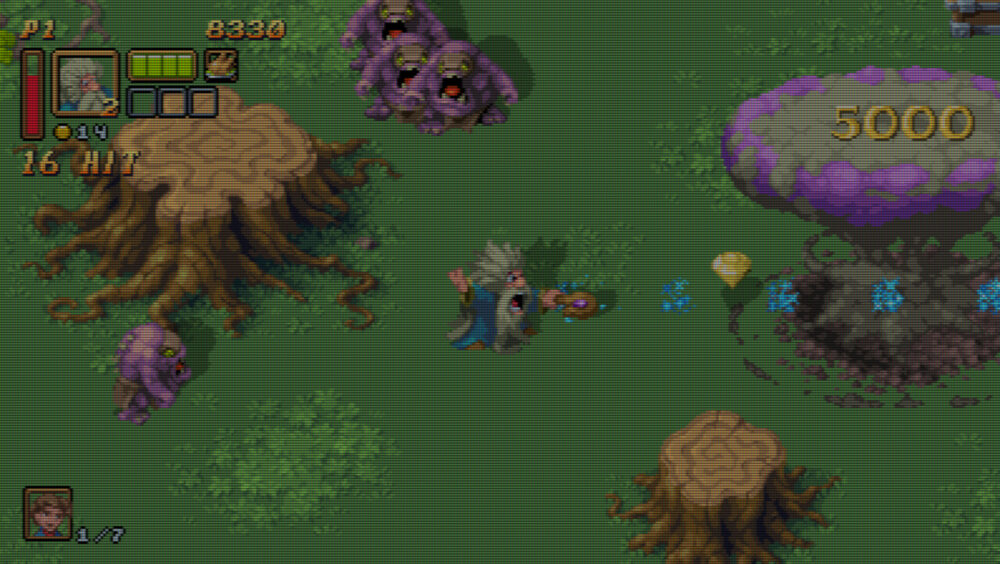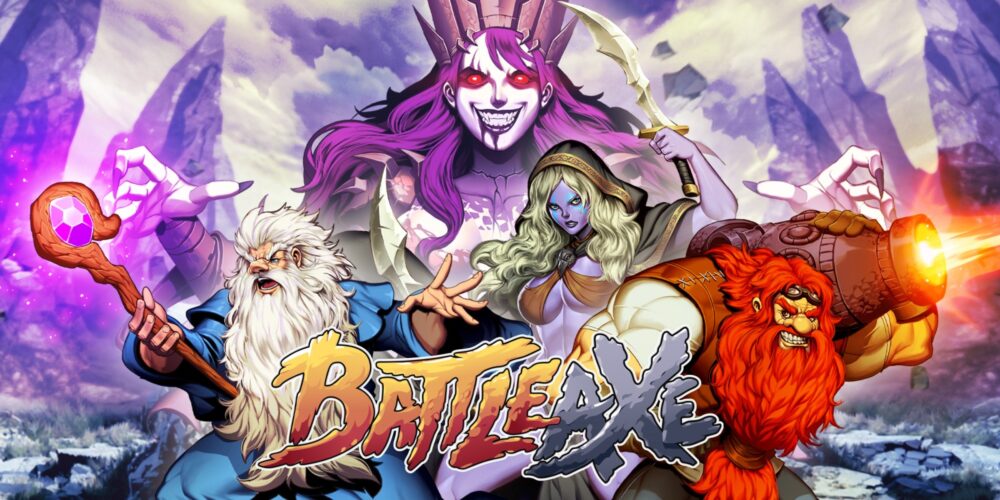Battle Axe – developed by Bitmap Bureau and published by Numskull – is an arcade-style, isometric hack-and-slash that is retro to a fault. It seeks to emulate both the gameplay and aesthetics of the 16-bit era and succeeds with aplomb. The question is whether that is enough for you in 2021?
The story, for what it’s worth, provides little context for the hours of tense and relentless combat on offer. The kingdom of Mercia is ruled but the tyrannical sorceress Etheldred. The previous group of mercenaries sent to stop her has never returned. Now, it’s up to a new party of heroes: Fae the swift, blade-wielding Elf; Iolo the fireball-tossing Druid; or Rooney, a Marauder who hauls around a cannon.

Battle Axe is not going to win any awards for its writing or world-building. Instead, it aims to impress by providing fast-paced hack-and-slash action with a degree of authenticity few retro indies manage to achieve. The basic campaign structure is exactly as I “remember”: pick a hero, battle through short but difficult stages, defeat the boss at the end, progress to the next stage, hope you don’t run out of lives.
Controlling your heroes and engaging in combat is easy to grasp but tough to master. You have 8-way movement, one button for melee attacks, one button for ranged attacks, and one button to use a consumable item. Each hero has slightly different movement speeds and attack rates (for both melee and ranged): Fae darts about with dual-blades and throwing daggers; Iola swings his beard for a sweeping attack but truly excels at flinging fireballs rapidly; Rooney has a slow ground-pound attack, but his cannon offers greater range than the others. Regardless of your preference, each character hits hard and the damage dealt feels consistent, ensuring all are viable in combat.

When it comes to the basic gameplay loop, Battle Axe sticks to its arcade inspirations. Swift kills that boost a combo meter are rewarded with increasing scores, while bonus points are earned for clearing the stage as fast as possible. Saving villagers along with the way and collecting gems from fallen foes also boost the final score. It’s a system that encourages you to replay levels, mastering your pathing, memorising enemy spawns, learning boss attack patterns.
After picking a character – and ideally having a companion on the couch to join you – you can pick a new “Arcade” run through four increasingly tough stages or tackle a wave-based “infinite” mode, which tasks you with rescuing villagers and destroying generators as quickly as possible before teleporting to a new area. Either option throws you into the thick of battle, with enemies literally spawning from the skies at times. The game defaults to “hard” difficulty but even on easy – which reduces enemy numbers – you’re in for a rough time compared to modern titles.

As in so many isometric titles from the 16-bit era, your deadliest enemy is usually anything not standing in one of the 8 attack directions. Projectiles and traps that are not beholden to this limited range of motion are equally treacherous. As a result, effective positioning is the first skill you need to learn and you’ll curse the game many times over when you fall to an attack you feel you had no way of avoiding.
Most basic enemies will fall to one or two blows – regardless of the chosen difficulty – so managing numbers, avoiding the aforementioned projectiles/traps while battling, and rationing rare consumables are equally essential skills. Consumables consist of offensive or restorative items, while some permanent buffs (for the duration of your run at any rate) can be purchased from a shopkeeper between stages. Having a coop partner ramps up enemy numbers to absurd levels, but the ability to cover more angles is always a plus.

Battle Axe places presentation front and centre. Every press release and product page proudly highlight the pixel-art from veteran Henk Nieborg (Contra, Shantae, Mighty Switch Force!) and the soundtrack from Manami Matsumae (Mega Man, Shovel Knight, and Mighty No. 9), who has been in the industry even longer. The visuals are detailed and vibrant, with fluid sprite animations. The soundtrack perfectly complements the atmosphere of each stage and frenetic boss encounter. The aesthetics are an acquired taste, sure, but few retro-style games feel so close to the source material.
Unfortunately, that authenticity also means Battle Axe can feel light on content and incredibly unforgiving. With only four stages in the arcade mode and a handful of small, repetitive maps in infinite mode, overcoming the steep difficulty curve through numerous replays could be seen as a cynical way to increase playtime. You can unlock an NG+ mode, but this simply mirrors stages and ups the enemy count. While this structure was common in games from that era, there’s not even a “continue” option should you lose all three lives during a run (on easy or hard). You are simply thrown back to the menu and have to tackle each successive stage again.
Despite the challenge, I kept returning to Battle Axe for short bursts – even if I had to drop the difficulty down to easy so that I could complete the arcade mode. There’s a reason these arcade-style games managed to consume so many coins and drive home console sales at the time – the basic gameplay loop seems simple but is incredibly addictive. If you’re a fan of retro hack-and-slash games, and you’re willing to tolerate some retro design philosophies, Battle Axe is easy to recommend.
Battle Axe is available on Nintendo Switch, PlayStation, Xbox and PC
This review is based on the Xbox version of the game which can be purchased here for £24.99
Enjoy the review? want to read more of our reviews? then click right here to be whisked away to the realm of our opinions.








You must be logged in to post a comment.